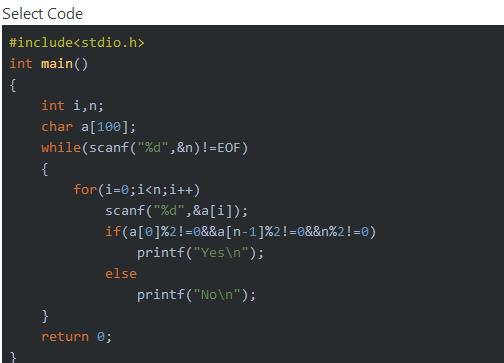Where do odds begin, and where do they end? Where does hope emerge, and will they ever break?
Given an integer sequence a1, a2, ..., an of length n. Decide whether it is possible to divide it into an odd number of non-empty subsegments, the each of which has an odd length and begins and ends with odd numbers.
A subsegment is a contiguous slice of the whole sequence. For example, {3, 4, 5} and {1} are subsegments of sequence {1, 2, 3, 4, 5, 6}, while {1, 2, 4} and {7} are not.
InputThe first line of input contains a non-negative integer n (1 ≤ n ≤ 100) — the length of the sequence.
The second line contains n space-separated non-negative integers a1, a2, ..., an (0 ≤ ai ≤ 100) — the elements of the sequence.
Output "Yes" if it's possible to fulfill the requirements, and "No" otherwise.
You can output each letter in any case (upper or lower).
3 1 3 5
Yes
5 1 0 1 5 1
Yes
3 4 3 1
No
4 3 9 9 3
No
题目的意思是给你长度为n的数字串,它是否能够被分割成1.奇数个小数字串2.数字串长度也是奇数3.小数字串的头和尾都是奇数
那么思路就是分为
1.如果第一个数字是偶数或者最后一个数字是偶数,这时候一定不会符合条件
2.如果长度为N的数字串的头和尾都是奇数,长度n也是奇数,这时候一定符合条件。
3.如果长度为N的数字串的头和尾都是奇数,长度n也是偶数,这时候一定不符合条件。(奇数个奇数长度的数字总长度一定是奇数。奇数*奇数=奇数)
这样只有条件2符合
只要

